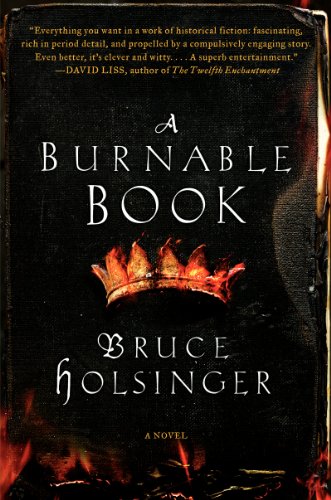A Burnable Book
A Burnable Book pitches you headlong into London, 1385, during the uneasy reign of Richard II. The story bursts with historical figures, including the hero, John Gower (poet), and secondary characters Geoffrey Chaucer (the ‘father of English literature’), John Rykener (transvestite), and Sir John Hawkwood (mercenary). The drama begins with a prostitute witnessing the killing of a girl on Moorfields, following which the prostitute flees with the article for which the murder was committed – a book prophesying the death of kings, including the as-yet-alive Richard. The remainder of the story involves the hectic search for this ‘burnable book’ (primarily by Gower at the behest of his friend Chaucer) and the unravelling of the threat to the king it embodies. But make no mistake – Holsinger spins no simplistic conspiracy tale, but an intricate and multi-layered collusion of agents, each pursuing separate goals and driven by differing needs.
I am in awe of Holsinger’s utterly convincing simulation of 14th-century London. A stroll around a bishop’s palace, a hand of cards, the intricate workings of the law, the haunts of prostitutes, religious processions and much more – the tale is steeped in wonderful and telling detail, which yet never descends into info-dump. Then too, as a professor of medieval literature, Holsinger is well able to furnish the literary background, not least his own artful construction of poetic prophecy.
I am less keen on Holsinger’s character construction, particularly that of Chaucer and Gower. Information provided by narration frequently clashes with character actions. Gower is asserted to be a talented and notorious blackmailer, yet he is naively manipulated from beginning to end. Perhaps more seriously, the uneven characterisation of Chaucer – womaniser, friend to mercenaries, and insulter of Gower’s poetry – is at odds with his deeply humane and thoughtful poetic legacy.
In sum: a well-researched and plotted historical thriller.










